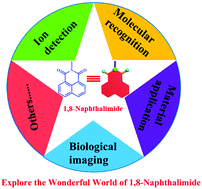1,8-Naphthalimide-based fluorescent chemosensors: recent advances and perspectives
Abstract
1,8-Naphthalimide, as one of the classical dyes and fluorophores, has been widely used in analytical chemistry, materials chemistry, and biochemistry fields because of its excellent characteristic photostability, good structural flexibility, high fluorescence quantum yield, and large Stokes shift. This review mainly focuses on 1,8-naphthalimide and its derivatives in ion detection, molecular recognition, material applications, and bioimaging in the past five years. Simultaneously, we hope to develop more powerful fluorescent chemosensors for broad and exciting applications in the future.

- This article is part of the themed collection: Journal of Materials Chemistry C Recent Review Articles


 Please wait while we load your content...
Please wait while we load your content...